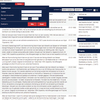De Digitale Charterbank Nederland
Grootschalige digitale bronontsluiting en het historisch onderzoek
DOI:
https://doi.org/10.51769/bmgn-lchr.6997Keywords:
geschiedenis, digitale geschiedenis, oorkonden, middeleeuwen, vroegmoderne tijdAbstract
In de Nederlandse archieven worden tienduizenden oorkonden (ofwel charters) bewaard uit de middeleeuwen en de vroegmoderne tijd. Dit materiaal vormt een onschatbare bron van informatie over allerlei maatschappelijke aspecten. Toch worden deze oorkonden in het historisch onderzoek nog weinig gebruikt, vanwege de gecompliceerde heuristiek: de documenten zijn verspreid over tientallen archieven en honderden archieffondsen. De Digitale Charterbank Nederland (DCN) maakt het grootste deel van dit corpus nu toegankelijk in een geïntegreerde database, waarin alle stukken vindbaar zijn. Ons artikel bespreekt de opzet van DCN en de praktische consequenties daarvan voor de gebruiker. De database kent specifieke mogelijkheden maar ook bepaalde beperkingen, en dit artikel toont hoe DCN kan helpen bij zowel gedetailleerd onderzoek naar personen of plaatsen als bij brede studies over een lange periode. Tevens wordt ingegaan op de invloed van de nieuwe grootschalige digitale bronontsluitingen en de bijbehorende hulpmiddelen en technieken op het historisch onderzoek.
The Dutch archives hold tens of thousands of charters from the Middle Ages and early modern period, providing an invaluable source of information on various societal aspects. Yet, this material is scarcely used in historical research mainly due to its complicated heuristics: the documents are spread across dozens of archives and hundreds of archival funds. The Digitale Charterbank Nederland (DCN) now makes most of this corpus accessible through an integrated database in which all documents can be found. Our article discusses the set-up of DCN and its practical consequences for the user. The database has specific possibilities but also certain limitations, and this article shows how DCN can help with both detailed research into persons or places, and with more broadly oriented research covering a long period of time. The article further includes a reflection on the impact of new large scale digital source retrieval systems and the associated tools and techniques on historical research.
Actualiteitsparagraaf
Big data en historisch onderzoek
Tienduizenden bronnen in Open Access
Ze bevatten een schat aan informatie, maar zelfs historici gebruiken ze tot nu toe nauwelijks: tienduizenden oorkonden (ofwel charters) uit de periode 1000-1800. Deze officiële akten, die ons informeren over uiteenlopende zaken zoals schenkingen en verkoop van rechten en goederen, kerkelijke verhoudingen, internationale verdragen en wetsuitvaardigingen, liggen verspreid over tientallen archieven in Nederland. Dat maakt ze zeer moeilijk te vinden, maar daarin brengt de Digitale Charterbank Nederland (DCN) verandering. Dankzij dit digitale portaal zijn de bijna 190.000 stukken nu voor iedereen toegankelijk en doorzoekbaar. Zo kan iedereen – van professioneel historicus tot bevlogen leek – onderzoek doen naar bijvoorbeeld zijn eigen familiegeschiedenis of sociale, politieke en economische onderwerpen. In BMGN 136:3 bespreken Jan Burgers en Rik Hoekstra de mogelijkheden en beperkingen van DCN, en laten zij zien hoe onderzoekers deze database met vrucht kunnen gebruiken
Downloads

Downloads
Published
Issue
Section
License
Copyright (c) 2021 Jan Burgers, Rik Hoekstra

This work is licensed under a Creative Commons Attribution 4.0 International License.
Authors who publish with this journal agree to the following terms:
a) Authors retain copyright and grant the journal right of first publication with the work simultaneously licensed under a Creative Commons Attribution 4.0 International (CC BY 4.0) that allows others to share the work with an acknowledgement of the work's authorship and initial publication in this journal.
b) Authors are able to enter into separate, additional contractual arrangements for the non-exclusive distribution of the journal's published version of the work (e.g., post it to an institutional repository or publish it in a book), with an acknowledgement of its initial publication in this journal.
c) Authors are permitted to post their work online (e.g., in institutional repositories or on their website) prior to and during the submission process.
Authors are explicitly encouraged to deposit their published article in their institutional repository.











